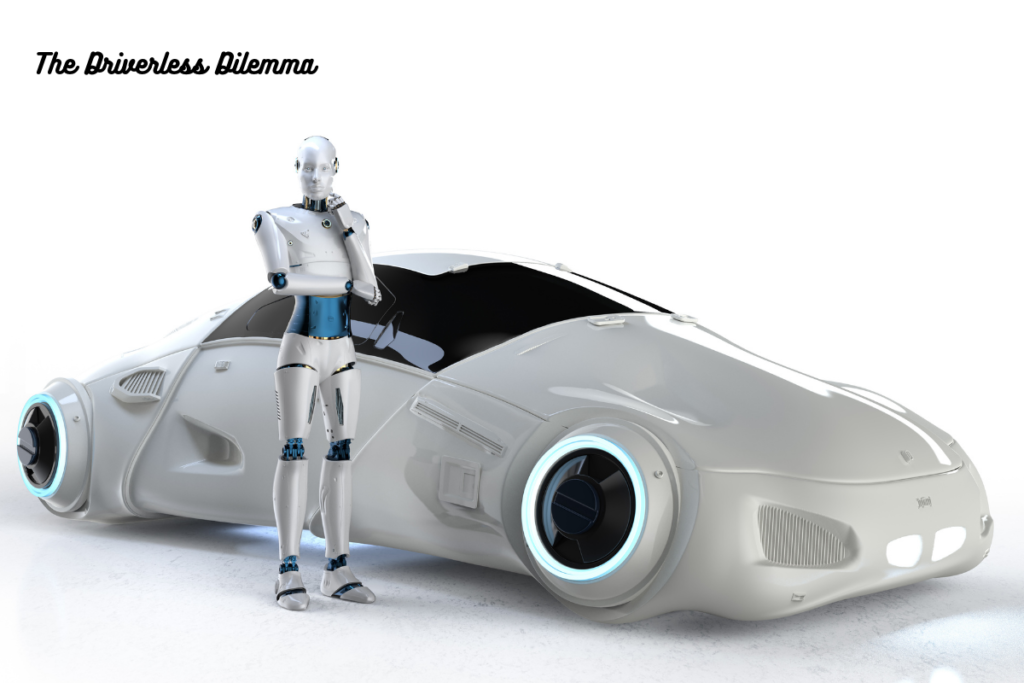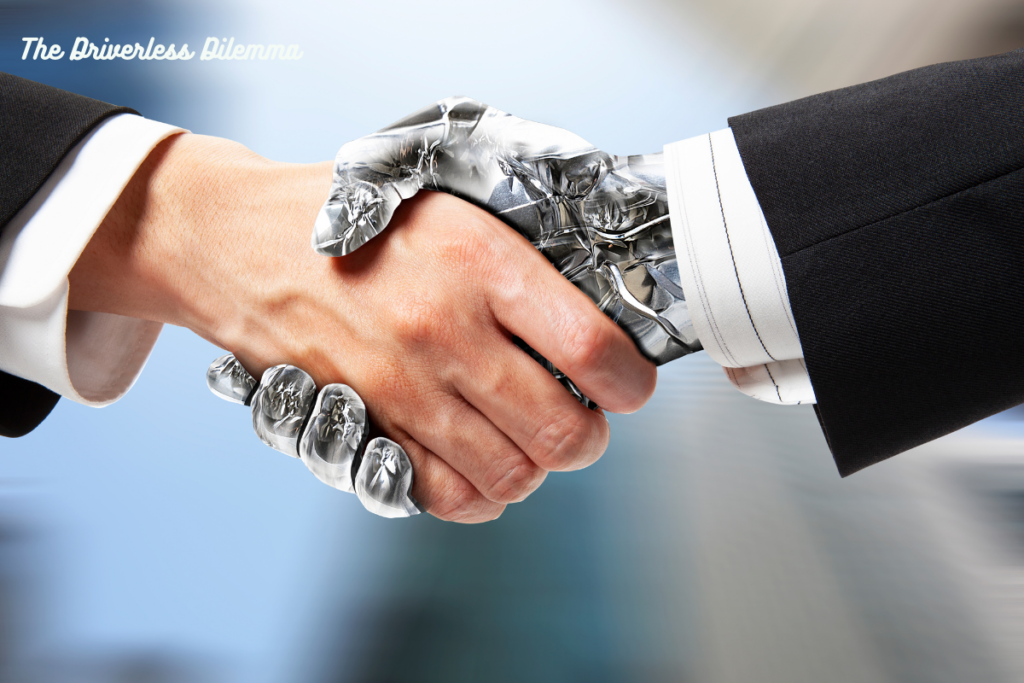Introduction:

Autonomous cars have evolved from the domain of science fiction into reality just about here in recent years. This developing technology promises a time when automobiles drive themselves, maybe lowering traffic congestion, perhaps preventing accidents, and thus redefining transportation. However, the development of such technology raises important psychological, ethical, and social issues, which are summed up in what has been called ‘The Driverless Dilemma”.
“The Driverless Dilemma” is the general ambiguity and several worries about accepting driverless cars. Fundamentally, this conundrum challenges our preparedness to let machines run our lives and addresses problems including safety, responsibility, and ethical programming of autonomous systems. Can we boldly let robots go on our road? How do we make sure these systems decide morally in trying circumstances? This conundrum affects the fundamental core of human confidence and the change in our interaction with machines, beyond technology.
The argument heats up as driverless cars develop. While some worry about situations in which machines must make life-and-death decisions, supporters point out the possibility for large declines in human error-related accidents. Dealing with “The Driverless Dilemma” calls for a multidisciplinary strategy comprising strong legal systems, technical innovation, and a society ready to accept and change with new standards.
Navigating the future of transportation requires this kind of inquiry. Understanding and tackling “The Driverless Dilemma” can help us prepare for a time when driverless cars are not only a curiosity but a reliable component of our daily lives.
Table of Contents
Safety Concerns:

“The Driverless Dilemma” captures a wide range of complex issues, among which the most important one is the safety consequences of adopting autonomous cars. With a technological revolution in transportation just about us, the issue of whether we can really rely on robots with our lives on the road looms huge. Understanding the nuances of “The Driverless Dilemma”, “from horsepower to AI power“, requires one to explore the safety dynamics.”
Adoption of autonomous cars presents great potential to lower traffic accidents. These cars are meant to run with unmatched accuracy free from the distractions and mistakes that sometimes afflict human drivers. Driverless automobiles might greatly improve road safety and lessen the effect of human error by using sensors, cameras, and artificial intelligence—cutting-edge technologies.
Underneath this surface of invention, though, is a complicated network of difficulties. Maintaining the safety of autonomous cars calls for thorough testing, exacting validation procedures, and ongoing performance monitoring. Furthermore unresolved concerns include how these vehicles will negotiate erratic road conditions, react to abrupt changes, and interact peacefully with human-driven cars.
“The Driverless Dilemma” invites us to squarely address these important safety issues. Although the promise of lower accidents is appealing, it should be emphasized underlined by a thorough framework giving safety top priority over all else. Only by carefully addressing these safety concerns will we be able to create the path for a day when autonomous cars transform our travel from point A to point B and inspire trust of society.
Ethical Programming:

“The Driverless Dilemma” presents a terrain rich in ethical complexity, none more significant than the moral conundrums linked with driverless car programming. Starting a trip into the world of autonomous cars begs a big question: can we let robots make difficult moral decisions on our behalf? “The Driverless Dilemma” centers ethical issues, which help to define our faith in this developing technology.
The programming of driverless cars calls certain choices that go beyond simple practicality and efficiency. These cars have to negotiate situations where moral considerations take front stage, therefore testing the basic foundation of their decision-making systems. In a case when a collision is inevitable, for example, how should a driverless automobile rank the safety of its occupants against that of pedestrians or other cars using the road?
Examining the moral conundrums related to autonomous cars helps us to negotiate a significant junction of philosophy, science, and society values. The very root of these issues emphasizes the critical part ethics will play in determining the direction of transportation. “The Driverless Dilemma” invites us to have important conversations, challenge the weight of moral obligation ingrained in robots, and shape a future in which ethical issues direct the direction of autonomous driving technology.
Human-Machine Trust:

“The Driverless Dilemma” provides a focus point for dissecting the complex interaction between people and machines, especially with relation to the difficult process of building confidence in autonomous driving technology. This essential feature of our changing relationship with technology emphasizes the subtleties and complexity behind our path to accept driverless cars.
The core issue of the difficulty is the basic one of trust. The foundation of the cooperation between humans and machines is trust. Developing this confidence in autonomous driving technology calls for a careful dance between technological ability, openness, and human acceptability. How can we build faith in a system that runs on its own, making snap judgments on our behalf?
Navigating “The Driverless Dilemma” calls for a great awareness of the elements influencing human confidence in technology. Safety, dependability, and ethical issues all come together to affect our readiness to hand off control to autonomous cars. Developing trust is not only a technical but also a profoundly human one driven on our natural need for security and predictability.
“The Driverless Dilemma” invites us to investigate new possibilities of cooperation and coexistence as we negotiate building a symbiotic relationship between humans and machines on the road. “The Self-Driving Car Revolution” gives us the opportunity to open the path for a day when autonomous driving technology effortlessly fits into our life and brings in a fresh era of mobility and invention by closing the trust-technology gap.”
Legal and Regulatory Frameworks:
“The Driverless Dilemma” highlights the crucial need of building thorough legal and regulatory systems to control the use of driverless cars and challenge the complex network of liability problems related with this revolutionary technology. This fundamental feature of the driverless revolution emphasizes the great influence laws have on the direction of autonomous driving and guarantees responsibility in unanticipated events.
“The Driverless Dilemma” is really about the urgent need for regulatory coherence and clarity. “Steering Towards the Future“, the absence of uniform regulations might lead to uncertainty about culpability, insurance coverage, and legal action in the event of accidents or malfunction as autonomous cars negotiate the complexity of real-world situations. Clearly defining the obligations of manufacturers, operators, and other participants in the autonomous ecosystem depends on strong frameworks.”
Policymakers, business leaders, and legal experts working together will help driverless cars evolve to create regulations that strike a mix between public safety and innovation. These systems have to solve a wide range of problems, including ethical decision-making algorithms, cybersecurity, and data privacy. Early resolution of these problems will help us create an atmosphere that promotes creativity and protects society’s interests generally.
“The Driverless Dilemma” emphasizes the need of creating legal and regulatory paths that foster innovation, guarantee responsibility, and inspire public confidence as we negotiate the difficult terrain of autonomous driving technology. By tackling this obstacle head-on, we can provide the foundation for a time when autonomous automobiles coexist peacefully with conventional cars, therefore changing the scene of mobility and redefining the limits of technological advancement.
Societal Readiness:

Fast approaching is the future of transportation; autonomous vehicles (AVs) will transform travel. But a vital question begs itself as we rush toward this automated future: is society ready for the broad acceptance of driverless cars? Sadly, there is no straightforward yes or no to the response.
AVs offer obviously possible advantages. For the elderly and crippled, they provide more mobility; they also promise to greatly lower traffic accidents and improve congestion. Moreover, they could enable smarter cities by allowing a more effective use of road and parking spaces.
Still, major issues that need to be resolved before general acceptance can take place overwhelm these benefits. “Job displacement” is one of main worries. For example, the trucking sector employs a lot of people; thus, the switch to autonomous vehicles might replace millions of drivers. Similar worries surround bus drivers, taxi drivers, and even delivery staff.
“Moreover, ‘social acceptance’ of AVs remains a big challenge. “The Future of Transportation” relies on developing public confidence in the technology, while concerns about security, ethics, and safety have to be resolved. This discomfort stems from questions about liability in the case of accidents, the role human intervention in key events plays, and the possibility of hacking and malevolent use of AVs.”
Beyond these pragmatic issues are “social and cultural considerations.” Driving now represents freedom, independence, and even a feeling of identity since it has grown somewhat rooted in our society. The shift to AVs could fundamentally change society and result in a societal change many would find disturbing.
“The Driverless Dilemma” addresses negotiating a complicated web of social, financial, and ethical ramifications rather than only the technology. To guarantee a seamless and fair transition to a future of autonomous transportation, we must carefully evaluate the requirements and concerns of many stakeholders, engage in education and public awareness, and build strong regulatory frameworks.
The success of AVs ultimately relies on society’s readiness and acceptance as much as on technical developments. This will call for honest communication, careful application, and a shared knowledge of the chances and difficulties ahead. Then only will we be able to fully negotiate the autonomous future and release its promise.
“The Driverless Dilemma” is a route we have to gently negotiate together.
Future Implications:
Although driverless cars offer a safer and more economical means of mobility, their broad acceptance could have long-term effects much beyond the road. This technical change could change our cities, our surroundings, and maybe our way of life.
Transportation Reimagined:
The change to driverless cars could completely change our way of getting around. Eliminating human error from the equation would cause a significant drop in accidents, therefore improving the safety of the roadways and lowering the medical expenses.
Driverless automobiles could also allow dynamic ride-sharing systems, therefore optimizing paths and reducing traffic congestion. This might therefore cause parking lots to diminish and precious urban land to be released for other purposes.
Urban Transformation:
The advent of driverless cars might open a new phase of urban design. Cities might be rebuilt around bike and pedestrian-friendly areas, therefore supporting better living and active transportation.
With consumers using on-demand fleets or subscription services for transportation, the idea of “car ownership” might become moot. More compact, denser, and lively city cores resulting from this could help to lower urban sprawl and perhaps ease the demand for large-scale infrastructure.
Environmental Sustainability:
The possible effect on environmental sustainability is really noteworthy. Operating with better efficiency and planned routes, driverless automobiles could help to lower fuel consumption and greenhouse gas emissions. They could also help to ease the shift to electric cars, therefore lessening our dependence on fossil fuels. Moreover, the change away from personal car ownership could result in a decrease in manufacturing and material consumption, therefore lowering the whole environmental impact of transportation.
Still, reaching these desired results calls for strategic management and meticulous preparation. The Driverless Dilemma. We have to guarantee fair access to driverless services, handle the possibility of job displacement and social inequity, and create strong rules to control the application of this technology. Furthermore deserving of great thought are the ethical ramifications of autonomous cars, especially in cases involving accidents or tough decisions.
Navigating this technical change offers both possibilities and difficulties in “The Driverless Dilemma.” It calls for a forward-looking strategy that takes into account not only the instant advantages of autonomous cars but also their long-term effects on our society, environment, and way of life. We have to travel this road together to make sure that transportation’s future is fair and sustainable as well as safe and quick.
Conclusion:
“The Driverless Dilemma: Will We Ever Trust Robots with Our Lives on the Road?” asks us to consider the difficult interaction of ethics, technology, and human confidence as we stand on the edge of a transportation revolution. The path toward embracing autonomous cars is not only about technology development but also a sociological change that forces us to face our anxieties, prejudices, and expectations about automation.
From safety issues and ethical programming to legal frameworks and social preparation, as we investigate the many aspects of “The Driverless Dilemma,” it is clear that trust will be absolutely important in this change. Only if we solve the issues preventing adoption and promote a cooperative connection between humans and machines will we be able to fully enjoy the possible advantages of autonomous vehicles—including lowered accidents, improved mobility, and environmental sustainability.
The ultimate question still is: will we ever be completely trusting of robots driving our lives? The solution is our capacity for honest communication, strong rules, and support of education and openness on autonomous technology. By doing this, we may negotiate “The Driverless Dilemma” and help to create a future in which autonomous cars are perceived as useful allies in our transportation system rather than as hazard.
People also ask:
Trusting self-driving cars depends on how safe, reliable, and moral the code is. Even though they offer fewer accidents, they need to be accepted by the public and regulated.
Self-driving cars can make roads safer by cutting down on human mistake. But their safety depends on strong technology, careful testing, and rules that work to make sure they are reliable.
Can you be more specific about the content of your article? After reading it, I still have some doubts. Hope you can help me.